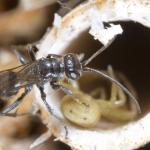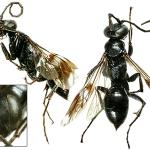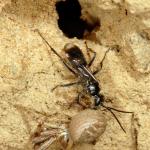An all-black species with bifasciate wings. Of the three British species of Dipogon, variegatus is easily separated in the female by its strongly-transverse propodeal sculpture. In the male these transverse wrinkles are present but less prominent; the subgenital plate is distinctive with long hairs ventrally.
Widely distributed in England, although more local in Wales. There is one recent record from Scotland, but only historic data from Ireland.
The species also occurs elsewhere in Euope and in North Africa
This species is not regarded as being scarce or threatened.
This wasp occurs in a wide range of open habitats - parkland, downland, heathland, coastal sites and suburban gardens.
It has been recorded from mid-May to early October.
Prey collected In Britain the prey seems to be exclusively the spider Xysticus cristatus (=viaticus) (Thomisidae) (pers. obs.; Richards & Hamm, 1939).
Almost any kind of pre-existing cavity may be used - dead plant stems, in dead wood, in the mortar of old walls, and even old snail shells. Nest cavities are plugged with grains of sand and other soil and plant fragments bound together with spider's silk collected by specialised bristles on the female's maxilla. Several cells may be constructed if space permits.
Never found on flowers (pers. comm. M Edwards). Adults have been recorded from Malaise traps and inside the windows of a house.




